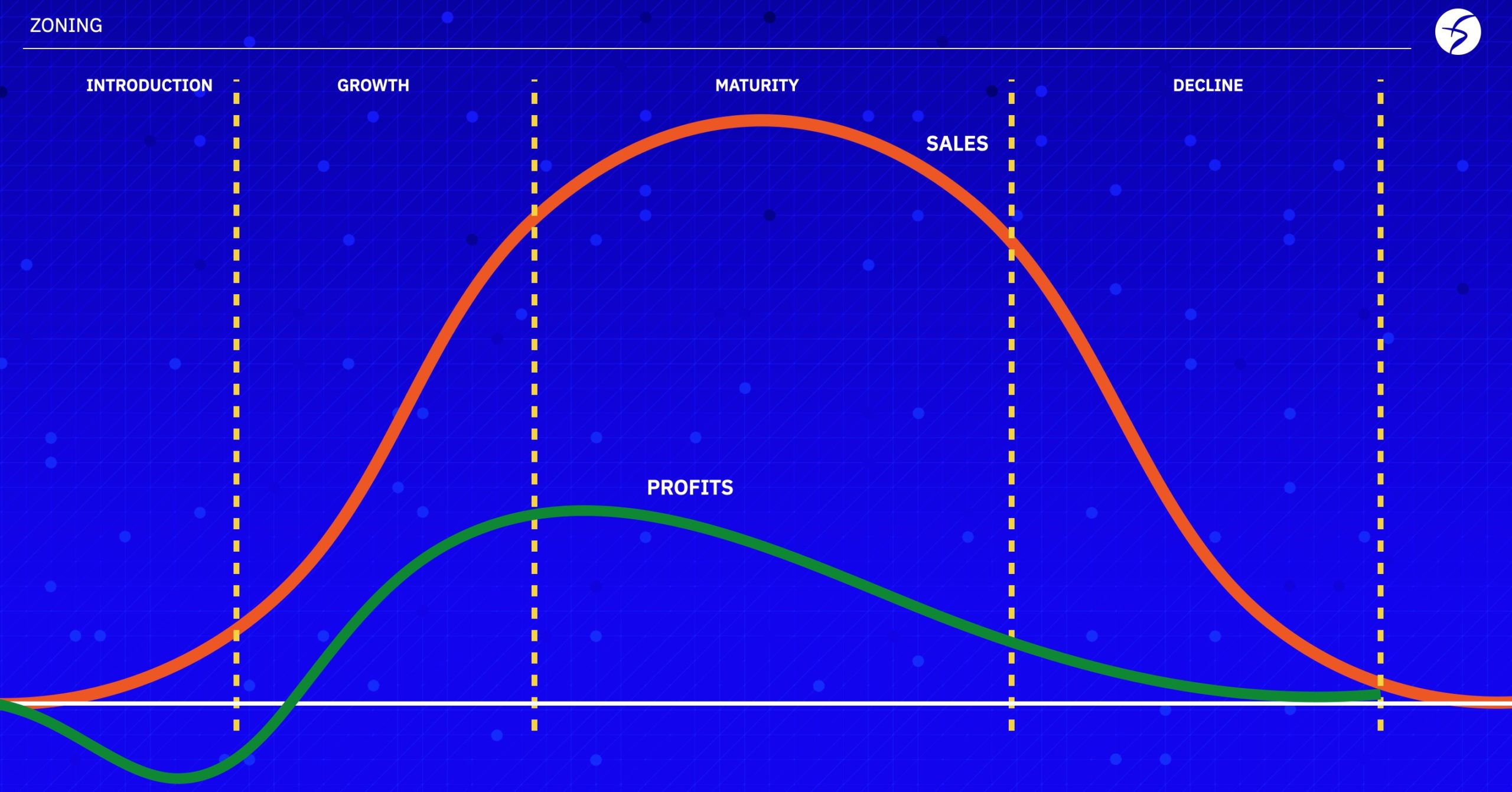How to start a product or service? How to find the right fit? How to hopefully scale it? How to decide and when to choose among all the available frameworks, methodologies, processes? Lean? Design thinking? Agile? Growth? Scrum? Kanban?…
Allow me to offer some suggestions. The set of processes we adopted at Pentalog is not a silver bullet, neither a religious mantra. But it does help to save time, money, energy, and to get your idea off the ground, then to scale if you find your Product-Market Fit. And eventually, to grow a great business.
So, you have an idea. You think the idea is terrific. You want to build as fast as possible. The market is just going to love it. But you don’t have all the time and money in the world. And, let me break the news to you, it is probably not going to happen the way you’d like. Now what?
Understanding the Product Life Cycle
Before you start, let’s take a quick look at the Product Life Cycle. Four phases:

- Introduction: from Prototype to Product-Market Fit. This phase has three stages. It goes from the idea stage where you build a prototype. Then time to ship the first version of your product [MVP (Minimum Viable Product) or MVO (Minimum Viable Outcome)]. And finally, you either pivot or look for a Product-Market Fit (PMF). At this last stage, you start to understand your funnel, the needs of your audience, their pain points. You have a good value proposition, a North Star, a growth model. You have several hypotheses on the “wow” moment…
- Growth: from PMF to Product Maturity. Go with a straightforward rule. If you don’t have a PMF, do not try to scale. It will not. One of the authors of Hacking Growth, Sean Ellis, applies the laws of 40%. Send a survey to your customers. Ask a simple question: “How would you feel if you could no longer use [your product]? Four possibilities: very disappointed, somewhat disappointed, not disappointed, N/A – I already stopped using it. If you don’t have 40%+ of your customers/users answering “very disappointed,” you don’t have a PMF. If you do have a PMF, you are starting to have an audience. Your “early adopters” are in. The “early users” are beginning to sign up. Churn is low—time to scale as fast as possible. Then, grab the “followers,” the guys who do what the “early users” do. They are the bulk of the audience. It is where the money is. Tests, tests, and tests again on a weekly basis. The more tests, the more answers.
- Maturity: maintaining your product. At this point, the goal is to max out the “followers.” Maintain your profitability. That’s the main challenge (see the green curve in the graphic). Reduce churn as much as possible. Monetize current users with up-sell and cross-sell. Reduce acquisition costs. Maintain the product without overspending on tech. Product Market Fit does not stop while you start scaling. We can argue it goes on until your expenses to maintain PMF does not allow you to generate solid EBIT. At this stage, it is all about profit margins, looking at the next wave, and incubating new ideas.
- Decline. It is harder and harder to maintain profitability. Competition is hurting you. You are losing customers faster than you acquire new ones. Acquisition costs are increasing. You have, hopefully, some promising innovations in your bag—time to try something new.
Money-wise during those four phases:
- In the Introduction phase, you are spending. No revenue.
- In the Growth phase, revenue is coming in and hopefully profits too. It is the golden age of the company.
- In the Maturity phase, revenue is still growing. When profits are declining and getting harder and harder to achieve, you are probably about 1/3 into the Maturity phase.
- Once you are in decline, profits are shrinking, revenue, too, until the business can’t sustain itself.

How long does it take to go from phase 1 to phase 4? It depends. About 33% of SMBs do not pass the five-year mark. A majority, 51%, are out of business before ten years. And the big ones have seen their lifespan decreasing from 61 years (1958) to 18 years (2016).
If you have read up to here, you are probably really motivated and eager to start. So, where do you start? How do you scale? Again, there are many ways to do so. We have selected the frameworks that we tend to use the most.
A. Create a prototype using a Design Sprint
So the first step is to build a prototype. As fast as possible, and to test it. The Design Sprint framework is an excellent and safe bet. In four or five days, you have a tested high-definition prototype. Yes! Less than a week. Not bad.
The Design Sprint process has been invented by Jake Knapp when he was at Google Ventures. He wrote a book – read it – called Sprint. He was sick of the time necessary to build a functional prototype and to test it. So he decided to develop his five-day framework inspired by Design Thinking and the agile methodology. The team at AJ&Smart reduced it to a four-day workshop, with eventually another iteration week. This is the approach we follow.
- On the first day, you frame the challenges and start thinking about how to solve them.
- The second day, you build the solution in the form of a storyboard.
- On the third day, you develop a high-definition prototype.
- On the fourth day, you test it with five people representing your target audience.
I know it sounds speedy. Maybe impossible. But it works. We have always ended up with a tested prototype and excellent feedback. If testers are not very convinced, go for an iteration sprint mainly focused on improving the prototype—no need for a third. If they are still not convinced at the end of the iteration sprint, you have a bigger problem.
B. Build your Minimum Viable Product (MVP)
Now you have the direction. Time to build your Minimum Viable Product. What is an MVP? We like to see it as the “first shipped product.”
I prefer the concept of Minimum Viable Outcome, invented by my friend and colleague David Golub after he read the excellent book of Jeff Gothelf and Josh Seiden, Sense and Respond.
Without going into too many details, the MVO focuses on concrete outcomes that are the necessary conditions to move ahead. Like acquisition cost, the number of customers, churn, etc., when the MVP has, in our experience, a tendency to focus on a set of features. Both are okay. It depends on the degree of linearity of the project. The more linear, the more the MVP, the less, the more the MVO makes sense.
More often than not, we build our MVP using an Agile framework. At this stage, Scrum or XP works well in general. It depends on the Agile maturity of your team. But, speed being at the essence at the MVP stage, often we find scrum being the more efficient methodology.
But classic agile is not enough. It would help if you also used a solid product testing framework to validate or not the hypothesis of your MVP. Building good software is not enough. It is where at Pentalog we introduce the Lean approach to make sure testing is built into the MVP.
Often the timing question pops up. How long should it take to build an MVP? Six weeks is excellent. Eight too. But again, it depends on what you are making. Try to stay within two months.
C. Scale with your Product Market Fit (PMF)
From MVP or MVO to a mature product, you have a step in-between. This step is the Product-Market Fit. It has been introduced by the Lean Startup movement, created by Eric Ries but also people like the American entrepreneur Steve Blank.
The idea is simple. No chance your initial idea, expressed in the MVP, is right on the money. The idea is to experiment continually. Step by step, you better understand your ICP (Ideal Customer Profile), their needs, their decision buying process, their pains, the gains you proposed with your product, the message that resonates, and the best channels to reach out to them.
You enter into a cycle where you test hypotheses, measure, analyze, test again. The traditional Agile methodologies are often not enough. Furthermore, it depends on the maturity of your product team. You need to add a layer of testing proposed by the Lean approach to make sure business, marketing, UX, and devs are working together and listening to user feedback.
Now let’s be clear. One could argue that all of that is already in Agile (see: Agile manifesto). Which it is. But Lean helps structure the approach, if necessary.
We use scrum or XP with a Lean layer to build PMF. You could also go with Kanban. Again, it depends on the degree of linearity. Scrum provides a solid structure for continuous testing when you are still in the complex zone and not yet in the complicated zone. At this stage, you are transitioning between those two zones. We use the Cynefin framework to understand where we are—an excellent framework developed by Dave Snowden.
How long should you take to find a PMF? Minimize the time as much as possible, I would like to say. And, as long as you have money to figure it out. The reality is that finding your PMF takes time. Some are lucky, but they are by far the exception. Put clear milestones with clear OKRs (Objectives and Key Results). Review every three months. Decide to keep going or stop or pivot.
It is not abnormal to spend 3 to 5 years to build/find your PMF. It mainly depends on the patience of your investors or your capacity to finance it. But, I would not continue after five years. A timeframe also suggested by Geoffrey Moore in his book “Zone to Win”, which is a business framework that he developed while consulting for Microsoft. I would either pivot or stop.
D. Grow, grow, grow
The “early-users” are in. The churn is low. The retention is high. You probably have a PMF. Or at least the first version of your PMF. I tend to argue that during the growth period, you are continually improving the market fit.
Often here, we switch from Scrum to Kanban or XP. They are more adaptive methodologies. You are ready, you release. Critical to absorb a new layer: the growth one. You need to hack growth. Here we add to the agile method the necessary testing to grow and scale the product.
Traditional marketing does not work at an uncertain stage of development. Growth hacking is the approach we suggest, with continuous testing. This approach follows the principles developed by Sean Ellis in his book “Hacking Growth.”
How long do you have to scale? Here too, we follow the “Zone to Win” framework. Geoffrey suggests that any innovation should scale within two years. From an investor’s point of view, it makes sense. They and the market are not well known for their patience. Enjoy the ride!

 (4 votes, average: 4.00 out of 5)
(4 votes, average: 4.00 out of 5)







